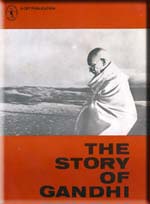
P.O. SEVAGRAM, DIST.WARDHA 442102, MS, INDIA. Phone: 91-7152-284753
FOUNDED BY MAHATMA GANDHI IN 1936
The Story of Gandhi

THE STORY OF GANDHI
Written by : Rajkumari Shanker
Table of Contents
- Birth And Childhood
- Preparation for England
- In England
- Back In India
- In South Africa
- In India
- Back In South Africa
- Indian National Congress
- In South Africa Again
- Assault
- Tolstoy Farm
- Returned To India
- Establishment of Satyagraha Ashram
- Benaras Speech
- Champaran Satyagraha
- Ahmedabad Mill-Workers Satyagraha
- Rowlatt Act
- Jallianwalla Bagh Massacre
- In Prison
- Salt Satyagraha
- Sevagram
- Cabinet Mission Plan
- Quit India
- He Ram!!!
About This Book
Written by : Rajkumari Shanker
First Edition :1969
I.S.B.N :81-7011-064-5
Published by :Children's Book Trust,
Nehru House, 4
Bahadur Shah Zafar Marg,
New Delhi 110 002,
India.
© CBT, 1969
Download
Chapter-15: Champaran Satyagraha
Now Gandhi heard about an obnoxious system of agricultural labour prevailing in Bihar.
In the Champaran district of Bihar, the cultivators were forced by Europeans to grow indigo, a blue dye, and this imposed on them untold sufferings. They could not grow the food they needed, nor did they receive adequate payment for the indigo.
Gandhi was unaware of this until an agriculturist from Bihar, Rajkumar Shukla, met him and told him of the woes of the people of Champaran. He requested Gandhi to go to the place and see for himself the state of affairs there. Gandhi was them attending the Congress meeting at Lucknow and he did not have time to go there. Rajkumar Shukla followed him about, begging him to come and help the suffering villagers in Champaran. Gandhi at last promised to visit the place after he had visited Calcutta. When Gandhi was in Calcutta, Rajkumar was there too, to take him to Bihar.
Gandhi went to Champaran with Rajkumar early in 1917. On his arrival the District Magistrate served him with a notice saying g that he was not to remain in the district of Champaran but must leave the place by the first available train.
Gandhi disobeyed this order. He was summoned to appear before the court.
The magistrate said, ‘If you leave the district now and promise not to return, the case against you will be withdrawn.’
‘This cannot be.’ replied Gandhi. ‘I came here to render humanitation and national service. I shall make Champaran m y home and work for the suffering people.’
A large crowd of peasants was outside the court shouting slogans. The magistrate and the police looked nervous. Then Gandhi said, ‘I shall help you to calm these people if I can speak to them.’
Gandhi appeared before the crowd and said, ‘You must show your faith in me and in my work by remaining quiet. The magistrate had the right to arrest me, because I disobeyed his order. If I am sent to jail, you must accept that as just. We must work peacefully. And violent act will harm out cause.’
The crowd dispersed peacefully. The police stared at Gandhi in admiration as he went inside the court.
The Government withdrew the case against Gandhi and allowed him to remain in the district. Gandhi stayed there to study the grievances of the peasants.
He visited many villages. He cross-examined about 8,000 cultivators and recorded their statements. In this way he arrived at an exact understanding of their grievance and the causes underlying them.
He came to the conclusion that the ignorance of the cultivators was one of the main reasons why it was possible for the European planters to repress them. Gandhi therefore set up voluntary organizations to improve the economic and educational conditions of the people. They opened schools and also taught the people how to improve sanitation.
The government realized Gandhi’s strength and his devotion to causes. They themselves then set upon a committee to enquire into the grievances of the cultivators. They invited Gandhi to serve on that committee, and he agreed. The result was that within a few months the Champaran Agrarian Bill was passed. It gave great relief to the cultivators and land tenants.
Gandhi could not stay longer in Bihar. There were calls from other places. Labour unrest was brewing in Ahmedabad and Gandhi was requested to help settle the dispute.